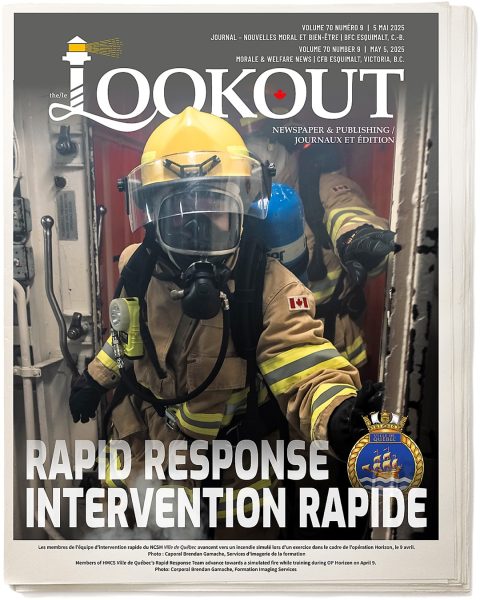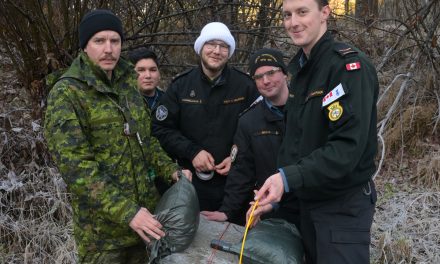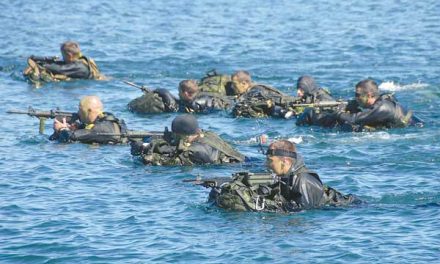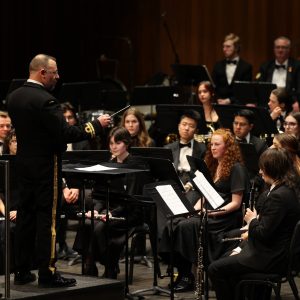Navy Public Affairs ~
Lt(N) Kevin Okihiro knew he would have to disarm nearly a dozen incendiary improvised explosive devices when he arrived at the small Cornish village of Upton Cross in South West England.
The moment seemed surreal and unfolded like his training, but it was not a drill.
The landlord of a car mechanic garage had come upon firebombs on the morning of Aug. 26, 2019.
“When we got the call I was on duty,” said Lt(N) Okihiro. “We are held at 10 minutes’ notice to move, so we have to respond quickly.”
The Royal Canadian Navy clearance diving officer has been posted to the United Kingdom (UK) on a three-year exchange with the Royal Navy Fleet Diving Squadron. The posting is to help him gain experience while acting as the No. 1 Improvised Explosive Device Disposal Operator and bomb disposal team leader on domestic operational taskings in support of UK Civil Authorities.
Over the past year in the UK, Lt(N) Okihiro has responded to 45 calls, but most were historic bombs and mines from the First and Second World Wars. None had been like this, with Improvised Explosive Devices (IEDs) purposefully placed under cars around a car mechanic’s garage.
“When I arrived the police, the fire service, and crime scene investigators were already on scene awaiting my team’s arrival.”
After everyone in the affected area had been evacuated and the area was blocked off, Lt(N) Okihiro spoke with the on-scene incident commander to get a better idea of what type of IEDs they had found.
Then, with his fireproof protective equipment on, he approached the first car.
“They were under cars and they were armed incendiary bombs. So, if I made a wrong a movement or was too aggressive there was a chance that I could trigger one. Because it was a car garage, the entire ground was covered in fuel. So that was a little bit problematic.”
He moved from car to car at his own pace, calmly and decisively reaching under each one to render each IED safe by hand. Their positioning under cars made reaching some of them awkward.
“It was just a matter of making sure my actions and what I was doing was precise.”
The investigation is still underway, but police have classified the incident as attempted arson, according to CornwallLive.com, the local news outlet.
After clearing each car, he had to search the entire area and worked with crime scene investigators to ensure the site was safe.
“I felt a huge sense of satisfaction on completion of the job. We train for years to become qualified and competent in preparation for something like this. It was really the coolest thing I’ve ever done.”
Since joining his team mates in the UK and responding to a variety of calls to disarm anything from hand grenades to 1,000 kg Second World War-era German bombs, his interest in explosive ordnance disposal has grown.
“The most exciting conventional call I’ve responded to was just after Christmas, where my team was tasked to dispose of two First World War British mortar bombs filled with Mustard Gas, two miles from Portsmouth Harbour. It’s such an amazing experience to put hands on the historical ordnance I read about in my youth, and ultimately be responsible for making them safe.
In the UK, legacy historical munitions are found every day, and a Royal Navy bomb disposal team is dispatched every 18 hours to respond to a callout. This adds up to about 300 calls per year per unit.
“I love this job. I love being on duty, taking tasking calls on the duty operator cell phone, preparing a plan and briefing the team, before departing the base at best speed in a blue-lit, emergency vehicle with ‘Royal Navy Bomb Disposal’ emblazoned on the sides. Without a doubt, this is the best job I’ve ever had.”
––––













